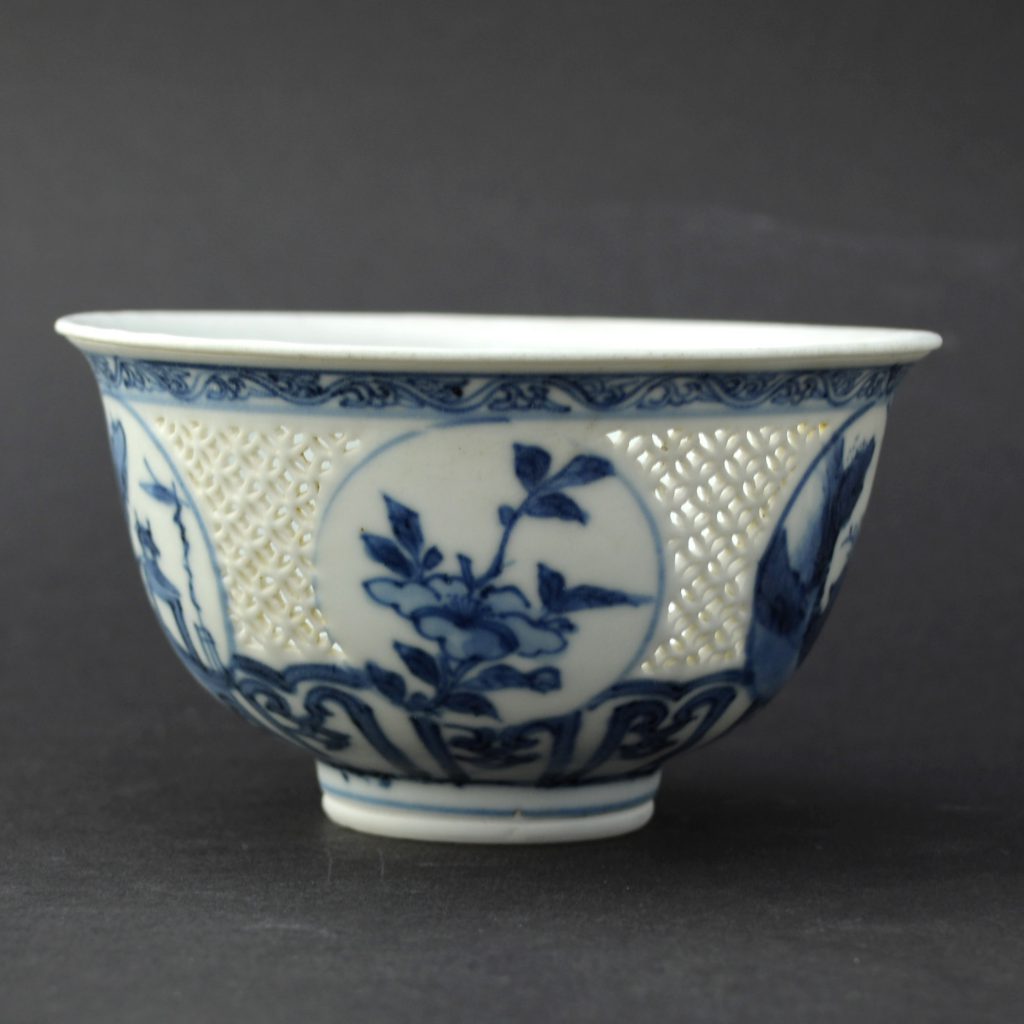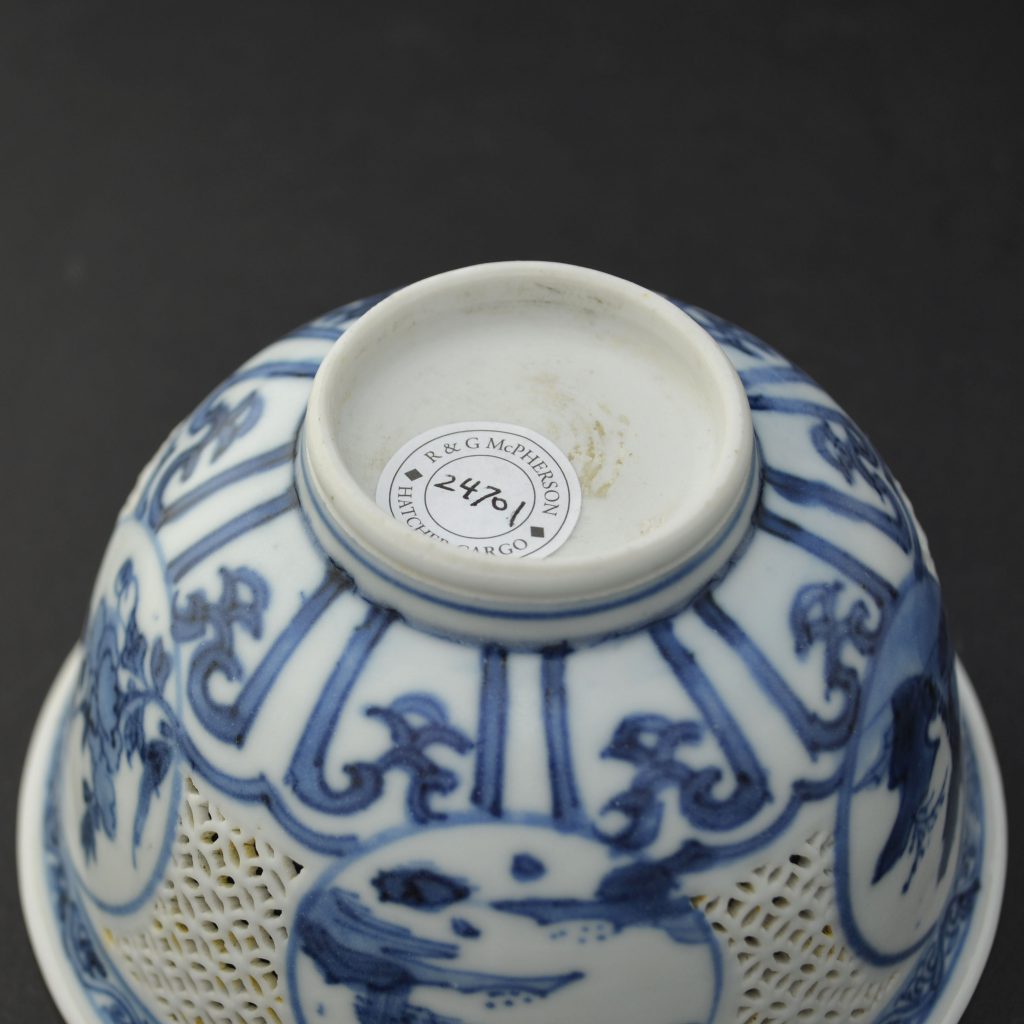
A Transitional Blue and White Porcelain Bowl with Reticulated Decoration, From the Hatcher Cargo c.1643.
A Blue and White Transitional porcelain Linglong bowl of a larger size than normal. From the Hatcher Cargo c.1643, Chongzhen 1628-1644 or Shunzhi 1644-1661. The deep sides are cut through to leave a reticulated `Cash` design. The circular panels are decorated with landscapes, Some of which are by water. The base is unglazed.
SOLD
- Condition
- The glaze is degraded due to immersion in salt water, the glaze surface is semi-mat.
- Size
- Diameter : 11 cm (4 1/4 inches)
- Provenance
- N/A
- Stock number
- 24701
- References
- A very similar Transitional Porcelain bowl is illustrated in : Chinese Ceramics of the Transitional Period 1620-1683 (China Institute in America, Stephen Little, 1983) page 72, plate 24. Reticulated blue and white bowls of this design and size were recovered from the Hatcher Cargo, see : Fine And Important Late Ming And Transitional Porcelain, Recently Recovered from an Asian Vessel in the South China Sea. Property of Captain Michael Hatcher. Christie`s Amsterdam 14th March 1984. The catalogue shows one lot of reticulated blue and white porcelain bowls of this type, containing six items, lot 196.
Information
The Hatcher Cargo :
The Hatcher Cargo was the first porcelain cargo from a shipwreck to come on to the market. It was sold in several auctions in Christie`s Amsterdam in 1984 and 1985. It remains one of the most important cargoes of shipwreck ceramics ever recovered, despite the lack of historical evidence recorded by the salvage team. Two porcelain covers dated 1643 helped date the wreck but this needed corroborating to give a firm date of the wreck and it`s cargo. The dating of the porcelain from the Hatcher Cargo is based on several elements. Firstly, the ceramics recovered form a coherent group, in other words they appear to all have been made at the same time. Secondly comparative dating was used to corroborate the date of the porcelain. For example, blue and white porcelain dishes decorated with a coiled serpent recovered from the Hatcher Cargo match an important dish from the fall of the Ming dynasty, formerly in the Percival David Foundation, now at the British Museum London, this dish can be dated to 1644 - 1645. Other comparative dating is also consistent with the presumed date of the porcelain. However, the most important dating reference remains the two covers recovered from the wreck datable by inscription to the spring of 1643. Although the the Ming dynasty officially ended in 1644 the transition from the Ming to the beginning of the Qing was messy and protracted. The porcelain made during this period of civil war and chaos is referred to as `Transitional Porcelain`. It covers the period from the last Ming Emperors until the early years of the Kangxi period, which is normally given a date of about 1620 to 1670 . The Hatcher Cargo is a vital dating tool for this previously poorly understood period of Chinese porcelain production.
Linglong / Reticulated Porcelain :
The present piece is an example of what can be referred to as `reticulated` porcelain, reticulated meaning having the form or appearance of a net, it was used as early the beginning of the 18th Century by the famous Père Francois Xavier d`Entrecolles (1664-1741) to describe this type of work on porcelain. Another popular term for this type of pierced or cut decoration is `Devils Work` or Guigong. However the Chinese term Linglong is gradually replacing the previous terms, helped by the publication of Jorge Welsh`s book `Linglong` (Jorge Welsh,London,2004.ISBN 972-99045-2-9). There does not seem to be any difference in the use of terms between the free standing pierced porcelain or that supported by an inner wall, nor a distinction made between the most refined work or the type with larger cut-out sections of porcelain.





